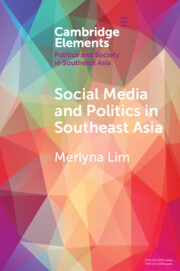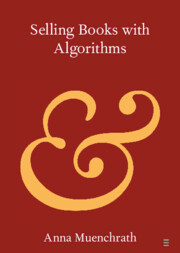Refine search
Actions for selected content:
150 results
6 - Making Social Media Pay for Its Sins
-
- Book:
- Killing the Messenger
- Published online:
- 05 September 2025
- Print publication:
- 25 September 2025, pp 118-145
-
- Chapter
-
- You have access
- Open access
- HTML
- Export citation
9 - Abstract Dynamic Programming
-
- Book:
- Dynamic Programming
- Published online:
- 17 July 2025
- Print publication:
- 31 July 2025, pp 260-273
-
- Chapter
- Export citation
10 - Do Algorithms Make Wise and Fair Decisions?
-
- Book:
- Understanding Technology and Society
- Published online:
- 30 September 2025
- Print publication:
- 10 July 2025, pp 120-136
-
- Chapter
- Export citation
‘I’d rather have memories that I can actually hold on to’: How young adults use and experience algorithmic memory technologies
- Part of
-
- Journal:
- Memory, Mind & Media / Volume 4 / 2025
- Published online by Cambridge University Press:
- 22 May 2025, e4
-
- Article
-
- You have access
- Open access
- HTML
- Export citation
11 - Disinformation and Algorithms
- from IV - Persuasion and Algorithms
-
-
- Book:
- Manipulation, Influence and Deception
- Published online:
- 10 June 2025
- Print publication:
- 24 April 2025, pp 223-249
-
- Chapter
- Export citation
9 - Seeking Postdigital Higher Grounds
-
- Book:
- The Comfort of Screens
- Published online:
- 10 April 2025
- Print publication:
- 17 April 2025, pp 160-175
-
- Chapter
- Export citation
2 - Literacy in Postdigital Times
-
- Book:
- The Comfort of Screens
- Published online:
- 10 April 2025
- Print publication:
- 17 April 2025, pp 26-45
-
- Chapter
- Export citation
4 - People with Screens
-
- Book:
- The Comfort of Screens
- Published online:
- 10 April 2025
- Print publication:
- 17 April 2025, pp 70-87
-
- Chapter
- Export citation
8 - People against Screens
-
- Book:
- The Comfort of Screens
- Published online:
- 10 April 2025
- Print publication:
- 17 April 2025, pp 142-159
-
- Chapter
- Export citation
Developing an algorithm to identify individuals with psychosis in secondary care in England: application using the Mental Health Services Data Set
-
- Journal:
- BJPsych Open / Volume 11 / Issue 2 / March 2025
- Published online by Cambridge University Press:
- 27 February 2025, e37
-
- Article
-
- You have access
- Open access
- HTML
- Export citation
A Challenge to Systematic and Undifferentiated Data Collection Through Strategic Litigation: The Passenger Name Record Case (Ligue des Droits Humains) Before the Court of Justice of the EU
-
- Journal:
- German Law Journal / Volume 25 / Issue 6 / August 2024
- Published online by Cambridge University Press:
- 24 January 2025, pp. 1068-1079
-
- Article
-
- You have access
- Open access
- HTML
- Export citation
4 - Internal Constraints on Judicial Behavior
-
- Book:
- Judges, Judging, and Judgment
- Published online:
- 03 January 2025
- Print publication:
- 16 January 2025, pp 60-86
-
- Chapter
- Export citation
More on EM for ML Factor Analysis
-
- Journal:
- Psychometrika / Volume 48 / Issue 2 / June 1983
- Published online by Cambridge University Press:
- 01 January 2025, pp. 253-257
-
- Article
- Export citation
Weighted Least Squares Fitting Using Ordinary Least Squares Algorithms
-
- Journal:
- Psychometrika / Volume 62 / Issue 2 / June 1997
- Published online by Cambridge University Press:
- 01 January 2025, pp. 251-266
-
- Article
- Export citation
2 - Algorithmic Regulation
-
- Book:
- Algorithmic Rule By Law
- Published online:
- 14 December 2024
- Print publication:
- 12 December 2024, pp 26-94
-
- Chapter
-
- You have access
- Open access
- HTML
- Export citation

Social Media and Politics in Southeast Asia
-
- Published online:
- 29 November 2024
- Print publication:
- 02 January 2025
-
- Element
- Export citation
Conclusion
-
- Book:
- Ethics in Econometrics
- Published online:
- 14 November 2024
- Print publication:
- 28 November 2024, pp 281-286
-
- Chapter
- Export citation

Selling Books with Algorithms
-
- Published online:
- 24 November 2024
- Print publication:
- 28 November 2024
-
- Element
- Export citation
Template-based piecewise affine regression
-
- Journal:
- Research Directions: Cyber-Physical Systems / Volume 2 / 2024
- Published online by Cambridge University Press:
- 06 November 2024, e5
-
- Article
-
- You have access
- Open access
- HTML
- Export citation
The uneven deployment of algorithms as tools in government: evidence from the use of an expert system
-
- Journal:
- Data & Policy / Volume 6 / 2024
- Published online by Cambridge University Press:
- 25 October 2024, e50
-
- Article
-
- You have access
- Open access
- HTML
- Export citation
